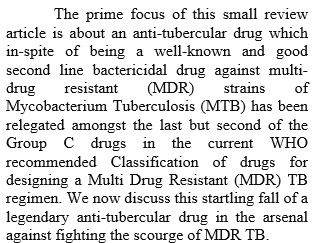Ethionamide in MDR TB: The fall of a legend
Abstract
The prime focus of this small review article is about an anti-tubercular drug which in spite of being a well-known and good second line bactericidal drug against multi-drug resistant (MDR) strains of Mycobacterium Tuberculosis (MTB) has been relegated amongst the last but second of the Group C drugs in the current WHO-recommended Classification of drugs for designing a Multi-Drug Resistant (MDR) TB regimen. We now discuss this startling fall of a legendary anti-tubercular drug in the arsenal against fighting the scourge of MDR TB.
Downloads
References
WHO consolidated guidelines on drug-resistant tuberculosis treatment", 2019, Geneva.
Van Deun A, Maug AK, Salim MA, Das PK, Sarker MR, Daru P, Rieder HL. Short, highly effective and inexpensive standardized treatment of multidrug-resistant tuberculosis. Am J Respir Crit Care Med. 2010 Sep 1;182(5):684-92. doi: 10.1164/rccm.201001-0077OC. Epub 2010 May 4. PMID: 20442432.
Zheng, XB., Diwan V.K., Zhao, Q. et al. Treatment quality and outcome for multidrug-resistant tuberculosis patients in four regions of China: a cohort study. Infect Dis Poverty 9, 97 (2020).
Cooperative Study Unit on Chemotherapy of Tuberculosis of the National Sanatoria in Japan. Comparison of the clinical usefulness of ethionamide and prothionamide in initial treatment of tuberculosis: tenth series of controlled trials. Tubercle 1968; 49: 281–290.
Fox W, Robinson DK, Tall R, et al. A study of acute intolerance to ethionamide, including a comparison with prothionamide, and the influence of a vitamin B-complex additive in prophylaxis. Tubercle 1969; 50: 125–143.
Verbist L, Cosemans J, Prignot J, et al. 20th Conference of IUATLD. Double blind study on the tolerance to prothionamide and ethionamide in original treatment of tuberculous patients. Bull Int Union Tuberc 1970; 43: 97–108.
Trébucq A, Schwoebel V, Kashongwe Z, et al. Treatment outcome with a short MDR-TB regimen among patients with rifampicin-resistant TB in nine African countries. Int J Tuberc Lung Dis 2018; 22: 17–25.
Genetic mutations associated with isoniazid resistance in Mycobacterium tuberculosis: a systematic review. Seifert M, Catanzaro D, Catanzaro A, Rodwell TC PLoS One. 2015; 10(3):e0119628.
Matsui T, Pinhata JMW, Rabello MCDS, et al. Frequency of first and second-line drug resistance-associated mutations among resistant Mycobacterium tuberculosis clinical isolates from São Paulo, Brazil. Mem Inst Oswaldo Cruz. 2020;115:e200055. doi:10.1590/0074-02760200055.
Lee H, Cho SN, Bang HE, Lee JH, Bai GH, Kim SJ, Kim JD. Exclusive mutations related to isoniazid and ethionamide resistance among Mycobacterium tuberculosis isolates from Korea. Int J Tuberc Lung Dis. 2000 May;4(5):441-7. PMID: 10815738.
WHO. Guidelines for the programmatic management of drug-resistant tuberculosis. http://whqlibdoc.who.int/ publications/2008/9789241547581. (accessed July 30, 2010).
Giovanni Battista Migliori, Alimuddin Zumla, 148 – Anti-tuberculosis Agents, Editor(s): Jonathan Cohen, William G. Powderly, Steven M. Opal, Infectious Diseases (Fourth Edition), Elsevier, 2017, Pages 1264-1276.e2, ISBN 978070206285.



























